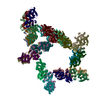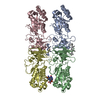+ データを開く
データを開く
- 基本情報
基本情報
| 登録情報 |  | |||||||||
|---|---|---|---|---|---|---|---|---|---|---|
| タイトル | Cryo-EM structure of CRISPR-associated cA4 bound Cat1 Pentagonal filament assembly | |||||||||
 マップデータ マップデータ | cryo-EM map | |||||||||
 試料 試料 |
| |||||||||
 キーワード キーワード | CRISPR / antiphage defense / adaptive immunity / Filament / CARF / TIR / cA4 / ANTIVIRAL PROTEIN | |||||||||
| 生物種 |  bacterium (バクテリア) bacterium (バクテリア) | |||||||||
| 手法 | 単粒子再構成法 / クライオ電子顕微鏡法 / 解像度: 3.4 Å | |||||||||
 データ登録者 データ登録者 | Majumder P / Patel DJ | |||||||||
| 資金援助 |  米国, 2件 米国, 2件
| |||||||||
 引用 引用 |  ジャーナル: Science / 年: 2025 ジャーナル: Science / 年: 2025タイトル: Cat1 forms filament networks to degrade NAD during the type III CRISPR-Cas antiviral response. 著者: Christian F Baca / Puja Majumder / James H Hickling / Dinshaw J Patel / Luciano A Marraffini /  要旨: Type III CRISPR-Cas systems defend against viral infection in prokaryotes by using an RNA-guided complex that recognizes foreign transcripts and synthesizes cyclic oligoadenylate (cOA) messengers to ...Type III CRISPR-Cas systems defend against viral infection in prokaryotes by using an RNA-guided complex that recognizes foreign transcripts and synthesizes cyclic oligoadenylate (cOA) messengers to activate CRISPR-associated Rossmann-fold (CARF) immune effectors. In this study, we investigated a protein containing a CARF domain-fused Toll/interleukin-1 receptor (TIR) domain, Cat1. We found that Cat1 provides immunity by cleaving and depleting oxidized nicotinamide adenine dinucleotide (NAD) molecules from the infected host, inducing a growth arrest that prevents viral propagation. Cat1 forms dimers that stack upon each other to generate long filaments that are maintained by bound cOA ligands, with stacked TIR domains forming the NAD cleavage catalytic sites. Furthermore, Cat1 filaments assemble into distinct trigonal and pentagonal networks that enhance NAD degradation. Cat1 presents an unprecedented chemistry and higher-order protein assembly for the CRISPR-Cas response. | |||||||||
| 履歴 |
|
- 構造の表示
構造の表示
| 添付画像 |
|---|
- ダウンロードとリンク
ダウンロードとリンク
-EMDBアーカイブ
| マップデータ |  emd_48629.map.gz emd_48629.map.gz | 253.8 MB |  EMDBマップデータ形式 EMDBマップデータ形式 | |
|---|---|---|---|---|
| ヘッダ (付随情報) |  emd-48629-v30.xml emd-48629-v30.xml emd-48629.xml emd-48629.xml | 17.4 KB 17.4 KB | 表示 表示 |  EMDBヘッダ EMDBヘッダ |
| FSC (解像度算出) |  emd_48629_fsc.xml emd_48629_fsc.xml | 16.8 KB | 表示 |  FSCデータファイル FSCデータファイル |
| 画像 |  emd_48629.png emd_48629.png | 76.2 KB | ||
| Filedesc metadata |  emd-48629.cif.gz emd-48629.cif.gz | 5.9 KB | ||
| その他 |  emd_48629_half_map_1.map.gz emd_48629_half_map_1.map.gz emd_48629_half_map_2.map.gz emd_48629_half_map_2.map.gz | 474.3 MB 474.3 MB | ||
| アーカイブディレクトリ |  http://ftp.pdbj.org/pub/emdb/structures/EMD-48629 http://ftp.pdbj.org/pub/emdb/structures/EMD-48629 ftp://ftp.pdbj.org/pub/emdb/structures/EMD-48629 ftp://ftp.pdbj.org/pub/emdb/structures/EMD-48629 | HTTPS FTP |
-検証レポート
| 文書・要旨 |  emd_48629_validation.pdf.gz emd_48629_validation.pdf.gz | 1.4 MB | 表示 |  EMDB検証レポート EMDB検証レポート |
|---|---|---|---|---|
| 文書・詳細版 |  emd_48629_full_validation.pdf.gz emd_48629_full_validation.pdf.gz | 1.4 MB | 表示 | |
| XML形式データ |  emd_48629_validation.xml.gz emd_48629_validation.xml.gz | 26.6 KB | 表示 | |
| CIF形式データ |  emd_48629_validation.cif.gz emd_48629_validation.cif.gz | 34.9 KB | 表示 | |
| アーカイブディレクトリ |  https://ftp.pdbj.org/pub/emdb/validation_reports/EMD-48629 https://ftp.pdbj.org/pub/emdb/validation_reports/EMD-48629 ftp://ftp.pdbj.org/pub/emdb/validation_reports/EMD-48629 ftp://ftp.pdbj.org/pub/emdb/validation_reports/EMD-48629 | HTTPS FTP |
-関連構造データ
- リンク
リンク
| EMDBのページ |  EMDB (EBI/PDBe) / EMDB (EBI/PDBe) /  EMDataResource EMDataResource |
|---|
- マップ
マップ
| ファイル |  ダウンロード / ファイル: emd_48629.map.gz / 形式: CCP4 / 大きさ: 512 MB / タイプ: IMAGE STORED AS FLOATING POINT NUMBER (4 BYTES) ダウンロード / ファイル: emd_48629.map.gz / 形式: CCP4 / 大きさ: 512 MB / タイプ: IMAGE STORED AS FLOATING POINT NUMBER (4 BYTES) | ||||||||||||||||||||||||||||||||||||
|---|---|---|---|---|---|---|---|---|---|---|---|---|---|---|---|---|---|---|---|---|---|---|---|---|---|---|---|---|---|---|---|---|---|---|---|---|---|
| 注釈 | cryo-EM map | ||||||||||||||||||||||||||||||||||||
| 投影像・断面図 | 画像のコントロール
画像は Spider により作成 | ||||||||||||||||||||||||||||||||||||
| ボクセルのサイズ | X=Y=Z: 0.73 Å | ||||||||||||||||||||||||||||||||||||
| 密度 |
| ||||||||||||||||||||||||||||||||||||
| 対称性 | 空間群: 1 | ||||||||||||||||||||||||||||||||||||
| 詳細 | EMDB XML:
|
-添付データ
-ハーフマップ: cryo-EM half map A
| ファイル | emd_48629_half_map_1.map | ||||||||||||
|---|---|---|---|---|---|---|---|---|---|---|---|---|---|
| 注釈 | cryo-EM half map A | ||||||||||||
| 投影像・断面図 |
| ||||||||||||
| 密度ヒストグラム |
-ハーフマップ: cryo-EM half map B
| ファイル | emd_48629_half_map_2.map | ||||||||||||
|---|---|---|---|---|---|---|---|---|---|---|---|---|---|
| 注釈 | cryo-EM half map B | ||||||||||||
| 投影像・断面図 |
| ||||||||||||
| 密度ヒストグラム |
- 試料の構成要素
試料の構成要素
-全体 : Antiviral protein Cat1 - Cyclic Tetra-Adenylate Complex
| 全体 | 名称: Antiviral protein Cat1 - Cyclic Tetra-Adenylate Complex |
|---|---|
| 要素 |
|
-超分子 #1: Antiviral protein Cat1 - Cyclic Tetra-Adenylate Complex
| 超分子 | 名称: Antiviral protein Cat1 - Cyclic Tetra-Adenylate Complex タイプ: complex / ID: 1 / 親要素: 0 / 含まれる分子: all 詳細: Cat1 protein forms filament structure upon recognition of cA4, Cyclic Tetra-Adenylate ligand. |
|---|---|
| 由来(天然) | 生物種:  bacterium (バクテリア) bacterium (バクテリア) |
-分子 #1: RNA (5'-R(P*AP*AP*AP*A)-3')
| 分子 | 名称: RNA (5'-R(P*AP*AP*AP*A)-3') / タイプ: rna / ID: 1 / コピー数: 15 |
|---|---|
| 由来(天然) | 生物種:  bacterium (バクテリア) bacterium (バクテリア) |
| 分子量 | 理論値: 1.271866 KDa |
| 配列 | 文字列: AAAA |
-分子 #2: Cat1 (CRISPR associated TIR 1) pentagonal filament
| 分子 | 名称: Cat1 (CRISPR associated TIR 1) pentagonal filament / タイプ: protein_or_peptide / ID: 2 / コピー数: 30 / 光学異性体: LEVO |
|---|---|
| 由来(天然) | 生物種:  bacterium (バクテリア) bacterium (バクテリア) |
| 分子量 | 理論値: 30.150592 KDa |
| 組換発現 | 生物種:  |
| 配列 | 文字列: MPQAFFSHNN KDKKIVLEVL EHLRQSLVAT WIDQQSIPGG GSLIQQIIAG ISKSQYFLAF LSNEYLKSDW CWDELEQAYA LHQKGKVKI IPILLTNRAQ LDLNALTDAR RNFLESILTR LKYVEFDPHN MTRSLGSVAE ALWQNEAVRF EPIRMIKVNG T ELQVVEFK ...文字列: MPQAFFSHNN KDKKIVLEVL EHLRQSLVAT WIDQQSIPGG GSLIQQIIAG ISKSQYFLAF LSNEYLKSDW CWDELEQAYA LHQKGKVKI IPILLTNRAQ LDLNALTDAR RNFLESILTR LKYVEFDPHN MTRSLGSVAE ALWQNEAVRF EPIRMIKVNG T ELQVVEFK IPGSNLPVDF LHHWDLKIED FIATSPNEQK PVKFDVPVAL YGPGPNWLYA FLTLPFKNRN TVFVFNSRTS EY ICVYSKS AGLAPGMVLK GHHHHH |
-実験情報
-構造解析
| 手法 | クライオ電子顕微鏡法 |
|---|---|
 解析 解析 | 単粒子再構成法 |
| 試料の集合状態 | filament |
- 試料調製
試料調製
| 濃度 | 1.2 mg/mL |
|---|---|
| 緩衝液 | pH: 6 |
| 凍結 | 凍結剤: ETHANE / チャンバー内湿度: 100 % / チャンバー内温度: 277 K / 装置: FEI VITROBOT MARK IV 詳細: liquid-nitrogen-cooled liquid ethane was used as the cryogen.. |
- 電子顕微鏡法
電子顕微鏡法
| 顕微鏡 | TFS KRIOS |
|---|---|
| 撮影 | フィルム・検出器のモデル: FEI FALCON IV (4k x 4k) 平均電子線量: 45.03 e/Å2 |
| 電子線 | 加速電圧: 300 kV / 電子線源:  FIELD EMISSION GUN FIELD EMISSION GUN |
| 電子光学系 | 照射モード: FLOOD BEAM / 撮影モード: BRIGHT FIELD / Cs: 2.7 mm / 最大 デフォーカス(公称値): 2.0 µm / 最小 デフォーカス(公称値): 0.8 µm |
| 試料ステージ | ホルダー冷却材: NITROGEN |
| 実験機器 |  モデル: Titan Krios / 画像提供: FEI Company |
 ムービー
ムービー コントローラー
コントローラー











 Z (Sec.)
Z (Sec.) Y (Row.)
Y (Row.) X (Col.)
X (Col.)





































